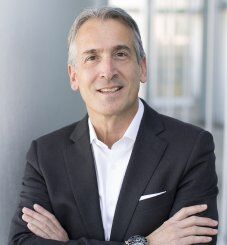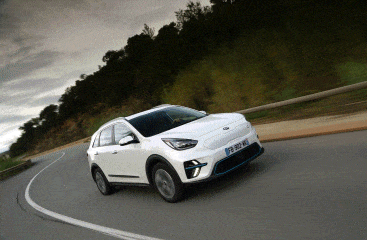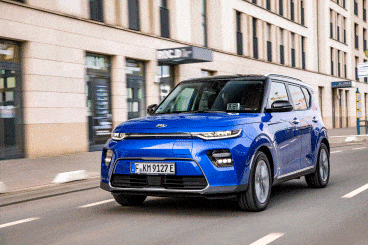 Frost & Sullivan’s Sarwant Singh spoke recently with Emilio Herrera, COO of Kia Motors Europe, and the man in the hot seat as he sets out to maneuver Kia Europe through what will undoubtedly be a tumultuous 2019. How will the rising popularity of SUVs play out against a backdrop of the 2021 deadline to reduce CO2 emissions? What electrification strategies will Kia adopt to meet the surging demand for electric vehicles? What opportunities and challenges does mobility as a service present for Kia? What factors have underpinned the resilience of this young Asian brand against its more established, European competitors?
Frost & Sullivan’s Sarwant Singh spoke recently with Emilio Herrera, COO of Kia Motors Europe, and the man in the hot seat as he sets out to maneuver Kia Europe through what will undoubtedly be a tumultuous 2019. How will the rising popularity of SUVs play out against a backdrop of the 2021 deadline to reduce CO2 emissions? What electrification strategies will Kia adopt to meet the surging demand for electric vehicles? What opportunities and challenges does mobility as a service present for Kia? What factors have underpinned the resilience of this young Asian brand against its more established, European competitors?
Sarwant Singh (SS): Despite being a young brand, you’ve done really well in the region. We did an analysis of the top 20 markets of Kia globally and 10 of them were from Europe, contributing to about 1/4th of your sales. What do you believe has contributed to this growth?
Emilio Herrera (EH): I think the main contributor has been the extraordinary products that we have launched. This was actually initiated in 2006 when Peter Schreyer, formerly a designer with the Volkswagen Group, joined the company. Coincidentally, we opened our first factory in Europe, in Zilina, Slovakia, at the same time. These two factors marked the start of a very successful period for Kia, so much so that the company remained unaffected by the world economic crisis. Peter Schreyer did tremendous work in completely changing the design of our vehicles and making them more acceptable to European consumers. Simultaneously, we kept adding products in new segments, making Kia much more competitive in every segment.
Another key milestone in Kia’s success in Europe has been our seven year warranty. Earlier, we used to have a 7-year warranty for some products built in Zilina. Then, in 2010, we decided to offer a seven year warranty for our entire lineup.
And finally, we have also been very successful over the past few years in launching electrified products and in positioning ourselves as one of the leading brands in terms of electrification.
SS: In terms of customer groups, you are very different from the Hyundai Group in that your customers are from a younger demographic. How have you achieved this customer acquisition because, typically, most Asian brands in Europe tend to struggle but both you and Hyundai have done well. How has your customer positioning contributed to this?
EH: About 10-15 years ago, the design and even the quality of our products was not even close to what we have today. We were selling vehicles mostly because our products had a very good price which was attracting a very different type of customer. Over the last 10 years, however, we have evolved and positioned ourselves as a design and quality oriented brand, an innovative brand that today attracts a very different type of customer. For example, we are winning over customers from traditional European brands and also from premium brands with our Niro, a vehicle for which we launched a plug-in hybrid and full electric version. These customers are completely new to the Kia brand.
Gaining new customers has been far more difficult for us than for any existing European brand. Not only because we are very young—we only started selling vehicles in 1974—but also because we started selling in Europe only in the early 1990s. The problem with our vehicles in the early stages of selling them here in Europe was that they lacked the quality and design finesse that we have today. As a result, they were mainly attracting consumers who were looking for the cheapest alternatives in the market. We could not retain those customers because, over the years, we have dramatically improved the design and equipment in our cars so they offer greater value for money. So we now are in a phase where we are selling every year to new customers and attracting a completely different type of consumer.
However, we are fighting against brands that have a century of history in Europe and that can count on a large customer platform. Both our customer loyalty and residual values have been increasing with the seven year warranty. When we sell a car after four years, we still have a warranty for three years which is, of course, boosting the residual value.
SS: You have a great range and an excellent product in the SUV compact/sub-compact market. How do you see the market for SUVs in Europe, particularly for Kia? Do you think Europe will go the same way as the US in terms of the market for sedans drying out and that for hatchbacks declining?
EH: There are two trends in Europe that are heavily impacting the type of vehicles that we sell. The first is the increased demand for SUVs and CUVs, which has been a constant factor over the past few years. Today, this has combined with the decline in diesel mix i.e. the diesel cars that we sell. These two factors are not necessarily helping us with meeting our CO2 targets here in Europe and are, in fact, in opposition because CUVs/SUVs are heavier and have higher CO2 emissions. It’s the same thing with diesel vehicles which have lower CO2 emissions and, therefore, the mix is now moving more towards petrol vehicles rather than diesel ones.
I don’t think that sedan cars are dead but it is clear that their share will constantly reduce. There has been a shift from the traditional C segment towards C-SUVs/ B-SUVs in every market in Europe. While this seems unstoppable, it is not necessarily helping us attain our CO2 targets. So we have to combine that with an offering of electrified vehicles. Every brand is trying to have some kind of electrification to be able to continue selling SUVs in Europe. This is unlike the US where there are lower restrictions on CO2 emissions. If we want to continue selling SUVs, therefore, we need to bring in electrification, either hybrid or PHEVS. So I think SUVs will continue to grow alongside the decline of sedans. However, I don’t think we can diagnose it as being the end of the road for sedans. We have a sedan like the Wagon that comes close to an SUV, in terms of dimensions and performance, and is popular in Sweden, Germany and Italy. We will continue to see such cars in Europe.

ES: Consumer behavior in Europe is heavily influenced by government taxation schemes. The best example is Norway where it is cheaper to purchase an electric vehicle (EV) than it is to purchase a traditional internal combustion engine (ICE) vehicle. This is driven by a decision of the government. Similarly, plug-in hybrids have suddenly become the car with the highest demand in Sweden ever since the introduction of a new taxation scheme based on Bolus Malus in July 2018. Again, this is not necessarily because consumers are more eco-friendly or more concerned with the environment—obviously some are but they are not the vast majority—but because consumer behavior is driven by government decisions.
There are a variety of situations here in Europe. Last March, 58.4% of the vehicles sold in Norway were battery EVs. In contrast, in Italy, this was 0.2%. Such discrepancies between countries are down to government support. France used to be a diesel market. However, with the government now granting €6000 for the purchase of an EV and an additional €2500 to scrap old vehicles, the cost of purchasing an EV is now the same as that of an ICE vehicle. Such government decisions underlie the sudden changes in markets. Our thinking is that demands will vary from market to market depending on the decisions of different governments, including those at the local level. As an OEM, therefore, we should be prepared to supply according to market needs.
In our forecasts for the next five years until 2025, we think that only a maximum 35% of vehicles could be EVs with the remainder being either PHEVs or hybrids, mild hybrids or traditional ICE vehicles. Some brands in Europe will struggle because they have not prepared for the future, but we already have two full EVs on the roads this year. We also have two PHEVs. We have a hybrid and, in future, will have more mild hybrids. And since demands will vary from market to market depending on the decisions of different governments, including those at the local level, auto manufacturers need to have the flexibility to increase the numbers of EVs, plug-in hybrid EVs (PHEVs) or mild hybrids, based on the demands of each market
SS: Kia Motors has been becoming more of a mobility company. Can you lead us through your mobility strategy, particularly your vision for Europe?
EH: The vision in Europe is to move slowly toward mobility as a service (MaaS). However, we still have to find the right model for it. We are looking at different options at this point in time. We already have one initiative—a car sharing company in Madrid—that we have been running since last summer as a JV with Repsol, the oil company. However, car sharing in Madrid is only one aspect of MaaS that we are looking at. Like other automakers, we are also exploring subscription.
The biggest issue with all the models we are evaluating today is achieving profitability. Another issue is that the lifecycle or the owner cycle will be shorter, so we have to ensure that we manage residual values efficiently. It is very difficult to make profits from the car sharing business because of the costs related to logistics, insurance, and the vehicles themselves. Subscription is the same. The more flexibility you provide to the consumer, the more costly it becomes and the less you earn. Quite honestly, all the models we have looked at so far don’t make any money at all.
We have set up a different company here in Kia Motors Europe that will deal with the services related to connected cars and telematics. The company will also deal with the different models and profit issues arising from MaaS.

EH: This company is already in place not only because of all the changes that I talked about but also because many OEMs have a very traditional structure and style of functioning. For example, if you are selling a service like a map update or entertainment through your connected car, you are probably looking to invoice €0.99 as iTunes does. The problem is that we do not have flexibility— in terms of organization, people or systems— that these new age technology companies have. We, therefore, need to create a different company to run these emerging businesses that will become an inherent part of the automotive industry.
But, today, we are set up like a traditional OEM which has a slower pace of change. We need people in this new organization with a start-up mentality. It is in the very early stages but with the launch of the e-Soul (EV), most of the cars we will launch henceforth will be connected. So we will have a large number of connected cars and we need to make sure that we are be able to do basic things like invoicing which is not easy because to manage two million invoices for €0.99 a day is neither simple nor something that we are used to. So it requires different mindsets, structures and processes, and that’s why we wanted to keep the company separate. We also need to make sure that it works faster than a traditional company which, typically, has lengthy and laborious internal decision processes.
SS: You talked about subscription, features on demand, and marketplace. Is this the future of the automotive industry?
EH: These are transition years. The coming years will be a mixture of traditional financing, subscription, and car sharing and that’s why, before the share of subscription and car sharing become too big, we need to find a way to make them profitable. This is our biggest challenge. The change from traditional leasing and renting to subscription will take a while, but one needs to be there and have a presence. It is like the electrification of cars, we need to be there. It won’t happen overnight but OEMs need to have them in their portfolios and be prepared just in case the market moves more rapidly than expected. Companies cannot ignore these trends because, otherwise, they might miss out on a huge part of the market. For instance, while traditional financing continues in some markets, private lease is picking up in countries like the Netherlands and the UK. So again, these are transition years where flexibility in both what you offer and how you offer it will be key.
SS: As COO, what are your goals?
EH: My focus is to continue growing the volumes here in Europe. We have some huge restrictions next year in terms of having to achieve a target of 95 gm/km for CO2. Keeping in mind that we have decided not to pay any fines, this means that we have to sell enough EVs to compensate for the CO2 emissions of our ICE vehicles. When we first started the exercise of figuring out how to go about doing this—for instance, if we had wanted to sell over 500,000 cars in 2020, the minimum number of EVs we would have needed to sell would have been about 32,000—the question was one of how we were going to sell so many EVs? Today, we are in the opposite situation where the demand for full EVs is so high that 32,000 vehicles will be easy to sell even this year. So we are in a situation where the only thing that will stop us from achieving higher sales volume is how many EVs we can manufacture.
Next year, the challenge will be more severe and we have to ensure that we reach those CO2 levels but, at the same time, continue to grow our volumes. And the only way to do that is to sell enough EVs to compensate. The exercise we have for next year, therefore, is very challenging because we have to assign to every market a certain number of EVs that they are capable of selling. A majority will be able to sell because there are many taxation schemes in place that subsidize EV purchases.
Competition will be fierce, especially in the second half of next year. Everyone will still need to produce a certain number of EVs to make sure they don’t have to pay fines. Some manufacturers will not be able to do it. Their only option will be to partner to make sure they reach the 95 gm/km target, like the Fiat and Tesla’s agreement. Other manufacturers will have to consciously reduce their volumes in order to keep a check on CO2 levels. Some manufacturers might even exit, deciding that it is not worth staying on in a complex European market where any profit they make has to be paid to the EU
From a Kia point of view, we are prepared. We forecast this scenario and knew exactly how many vehicles we had to sell in order to offset the CO2 restrictions. But, honestly, we’re finding it difficult to produce as many EVs to keep pace with high market demand. This year we will see close to 30,000 EVs in Europe but the real demand will be much higher. Similarly, the demand for electrified vehicles – PHEVs, mild hybrids and hybrids—is increasing and, like most other manufacturers, we are struggling to manufacture as many vehicles as we’d like to.
SS: Tell us about your leadership and management style. What works in a Korean organization like Kia here in Europe?
Kia is a good mix of Korean culture and European style management. Korean culture is about perseverance, a ‘go-for-it’, ‘never give up’, ‘challenge yourself’, ‘hard work will yield results’ and ‘do everything better than last time’ attitude. From my point of view, we need to find the right combination of all these attributes with the new leadership style used in Europe where you empower people, trust them to do their jobs, and accept failures. Luckily we have a new Executive Vice Chairman who is embracing the leadership style that we have here in Europe.
Personally, my way of leading an organization is to know exactly what is going on, and make assessments backed by facts and figures. It is also important to put the right people in the right positions and make sure they are empowered to do what they need to do in order to succeed.
Setting higher targets every time is another typical Korean trait. In some cases, this can be tough because you can reach a level where you wonder if you can set a higher target. But it pushes people to do the best they can and if you blend that with a more European leadership style, then you have a winning formula.



